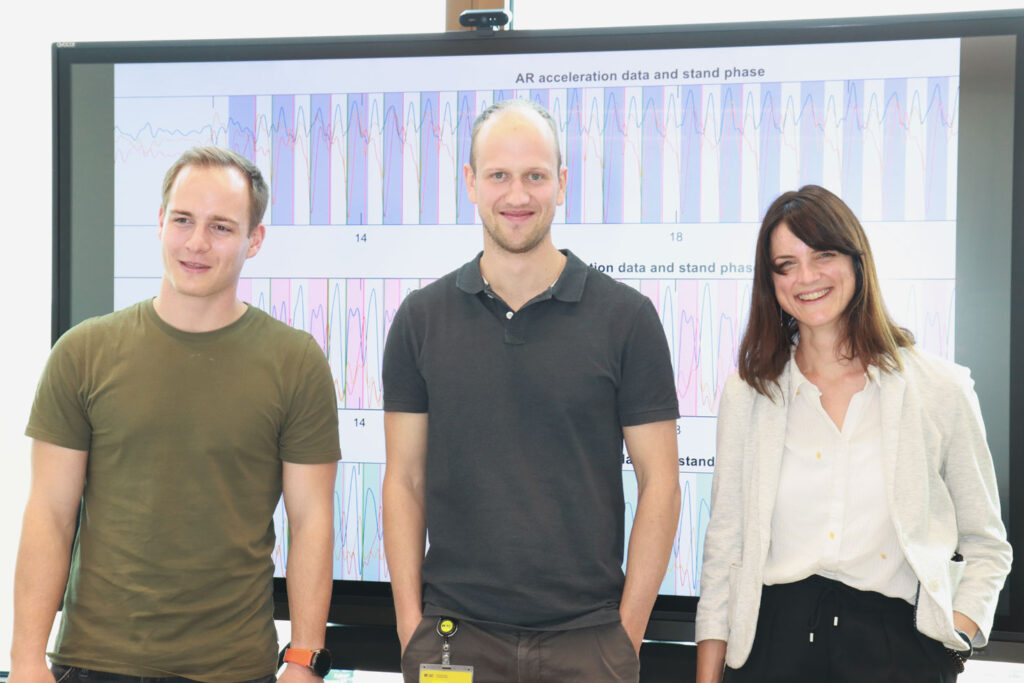“Diagnostic gait analysis”
In close cooperation with the research team of the University of Applied Sciences Northwestern Switzerland (FHNW) – consisting of Denise Baumann, Matthias Altermatt and Micha Bischofberger – 4Dvets is dedicated to the further development and optimisation of the gait analysis system LupoGait®. The project is supported by the Swiss Agency for Innovation Promotion Innosuisse.

From left to right: Micha Bischofberger, Matthias Altermatt, Denise Baumann
University of Applied Sciences Northwestern Switzerland, Institute for Medical Technology and Medical Informatics
The focus of the development process is the orientation of the measurement system towards early pathology detection. Initially, the system should help to detect hip dysplasia, and later potentially also elbow dysplasia, cruciate ligament tears and cauda equina syndrome, as far as possible before the onset of symptoms. To ensure this, new meaningful gait characteristic analyses are being developed and subjected to clinical validation. Machine learning (artificial intelligence) methods will also be used to help detect gait irregularities at an early stage. In addition, LupoGait® will be enhanced with a comprehensible 3D visualisation of the dog and the analysis results.
The usability and clinical validity of the entire expanded system will be examined in a study with at least thirty dogs at the end, and the knowledge gained in this way will be incorporated into the process of progressive optimisation of the system.
The FHNW Team
Denise Baumann
Project Manager, Research Associate, MSc in Biomedical Engineering
Denise Baumann’s passion lies in the development of software and algorithms for biomedical applications. At the Institute of Medical Engineering and Informatics (IM2) at the FHNW, she is mainly involved in projects in the field of motion analysis and therapy support, such as the development of a motion sensor-based system to support stroke patients during treatment. As a researcher and developer, she has been actively involved in the creation and optimisation process of LupoGait® for several years now and makes a significant contribution to ensuring the functionality and quality of the motion diagnostic product through her involvement in algorithm and software development, sensor integration and, among other things, testing and technical validation.
Due to her love of riding animals, Denise, as a former passionate horse owner, has studied the gait of horses in her spare time for many years. The experience she gained in this context led her to the realisation that she had to face a very special challenge in the development of LupoGait®: the fact that it is more difficult to grasp the movements of dogs with the naked eye than it is with horses due to their higher speed.
Matthias Altermatt
Research Associate, MSc in Biomedical Engineering
Matthias Altermatt works as a research assistant at the IM2 of the FHNW and is intensively involved in the field of algorithms for movement analysis and therapy support, including for example algorithms for the support of movement therapy after a stroke, which calculate relevant characteristics from data of an inertial (moment of inertia) sensor. These result values can be used for the conception of and during a successful therapy as well as for its individual adaptation and lead to an increase in the patients’ motivation through positive feedback. Matthias supports the LupoGait® project through his dedicated involvement in the development of the algorithm for the detection of the stance and swing phases and the range of motion of the joint.
What Matthias finds particularly interesting about the work on LupoGait® is the fact that, due to the impossibility of questioning the dogs as patients, the solution for correctly locating a movement problem lies in generating and interpreting the measured values.
Micha Bischofberger
Research Assistant, currently doing his MSc in Biomedical Engineering
Since completing his BSc in Medical Engineering in September 2020, Micha has been working as an assistant at IM2 in the field of motion analysis and therapy support. His main occupation is software development – for example for the stroke patient therapy system – as well as gait diagnostics and server implementation of LupoGait®. In this context, his field of activity includes the analysis of the developed gait parameters, the identification of the clinical statements represented by them and the way of their potentially necessary adaptation.
Micha Bischofberger was able to find confirmation of the value of his work on the LupoGait® gait analysis in his immediate environment: His family’s Hovawart had a shoulder problem that could be classified and surgically solved thanks to LupoGait®.
“Thanks to my work for LupoGait®, I was able to help our dog. That is very motivating.”
